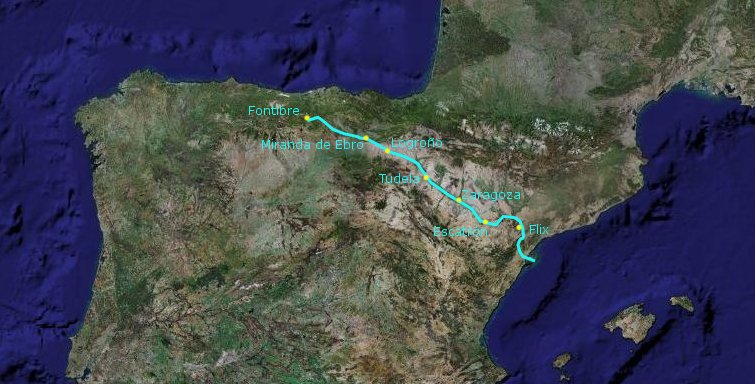| català | español | english | ||||||
| Ebre & kayak | The river | Stages | Links |
| Geography | |||||||||||||||
| The
Ebre is born in Fontibre, near Reinosa, at the cordillera
Cantábrica and flows east into the Mediterranean Sea after 910 km. From
the north it is feeded bt Pyrennees flows, and from the south from the
Iberian mountain range. Most of its path has a dry continental climate. The Confederación hidrográfica del Ebro has real time data about water levels: SAIH | |||||||||||||||
 | |||||||||||||||
| Permits | |||||||||||||||
| It is mandatory to make a statement to Confederación Hidrográfica del Ebro:
Declaration of responsability Instructions As stated in the instructions, CHE will assign a license number to the boat that should carried and visible. It must be reminded that the presence of the zebra mussel, an invasive species, in some reservoirs, poses certain restrictions that are detailed in the instructions. |
|||||||||||||||
| History | |||||||||||||||
| The name comes from "iber", that is, "the river of the ibers", the ancient tribe that inhabited the peninsule. Before Rome. There are traces of ancient villages along all teh river. Rome (I BC a V CE). The river marked the frontier between the Cartago zone in the south and Rome in the north. Pliny quotes the river as sailable until (then Vareia), along Zaragoza (Cesaraugusta) and Tortosa (Dertosa). Visigotic period (VI a VII) Muslim control (VIII a XV). Muslims spread and built irrigation. Later Enre will be again the frontier dividing the christian controlled zone in the north, and the muslim zone in the south. Tortosa was reconquered in the 12th century. Miravet became an important templar fortress. Modern age (XVI a XIX) Segle XX. The last part of the river, from Mequinença to Amposta, in 1938 was the field of one of the last and decisive battles in the spanish civil war, with the outcome of the defeat of the republican army and about 20.000 casualties between both parts. In the post war period dams and reservoirs and the river was sailable no more. Thel "Plan Hidrológico Nacional" of the late Partido Popular planned an important flow diversion that would shrink water levels to a point where the traditional rice cultivation and the humid habitat used by many migratory birds would have been no longer sustainable. This plan was cancelled by the following socialist government. | |||||||||||||||
| From Flix to the Sea | |||||||||||||||
| The last part of Ebre river crosses the land of Ribera
d'Ebre
with the towns of Flix, Ascó, Garcia, Móra d'Ebre i Móra la Nova,
Benissanet, Ginestar i
Miravet; the land ofl Montsià, with Amposta and the Baix
Ebre land, with Benifallet, Tivenys, Xerta, Aldover, Bítem,
Tortosa,
Amposta, Deltebre i Sant Jaume d'Enveja. Down to Xerta the river crosses the prelitoral mountain range, buit out of calcarean rocks, finding its way between hills. From Xerta on there are mountains only in the east shore and after Tortosa the delta plain extends on both sides.  Sailability www.ebrenavegable.com: rules and conditions for boats, water level data, Xerta's weir and a map of wharfs. Flora and fauna In the hills there is the mediterranean forest, with pine and holm oaks. A la muntanya hi ha bosc mediterrani de pins i alzines. Along the river, poplars, willows and reeds. In the delta rice fields extend. Here is a list of some of the species you can find, with a link to the wikipedia. I list only the ones that I have seen and recognised there are many more. I suppose that the bright blue point that flew horizontaly in front ofme for a while was a kingfisher. From time to time you will hear the splash of a carp jumping, sometimes about 1 meter out of the water.
Audouin offers ornitological tours at the delta. Gastronomy: Try the "clotxa" (in old times farmers emptied a bread and filled it with herring, tomato and onion, ) the rare refreshment of Suau Quim, the rice and 'anguila. ReadingsJoan Sebastià d'Arbó: Terres de l'Ebre. The history of three generations of farmers at the delta. In catalan. Tourist information Ebreguia. Excellent site with touristic routes, where to stay and to eat, notes about history and geography, etc. In catalan. You have an automatic translator at traductor.gencat.net. |
|||||||||||||||







